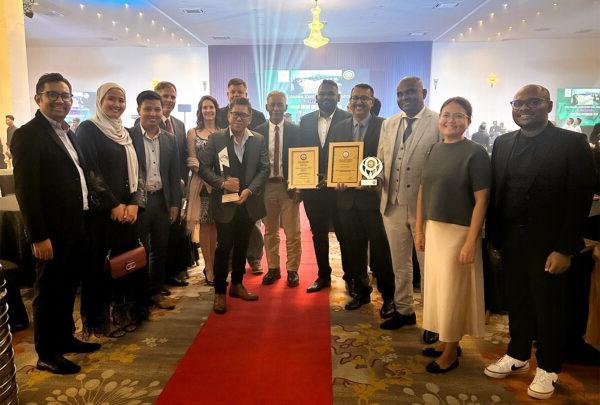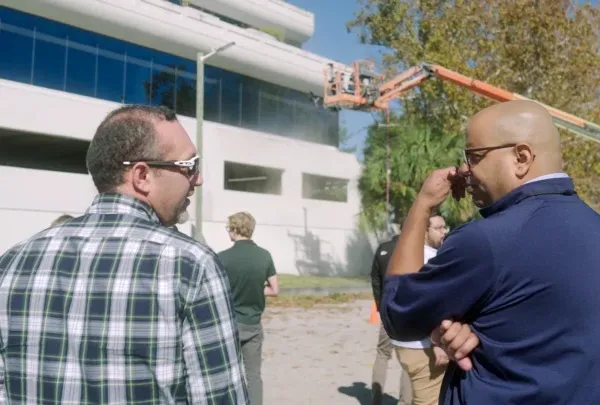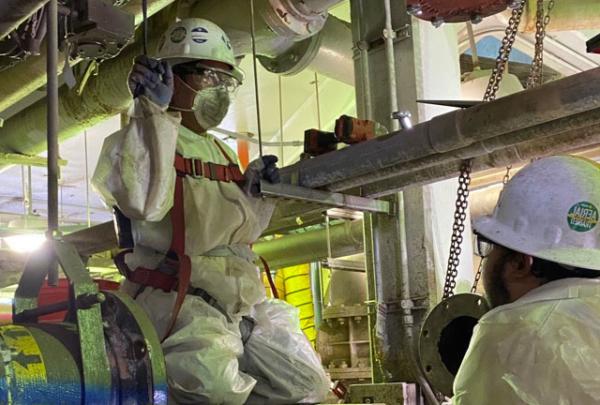Hangar 101 at Naval Air Station Jacksonville was one of the original buildings when the facility was officially commissioned in October 1940. After almost 80 years and numerous additions and internal modifications, the U.S Navy chose 澳门足彩app for the design-build project to undertake major repairs and renovation of the historic structure.
The U.S. Navy dictated that normal operations were to continue and the massive building remain occupied throughout the project. But when testing revealed lead-based paint, safety protocols precluded the use of accustomed paint-removal methods.
澳门足彩app and its environmental subcontractor, Boynton Beach, Florida-based Best-Tec, had to adapt. Best-Tec President Greg Kleirichert Jr., whose company provides environmental services that include asbestos removal, lead-paint abatement and mold remediation, suggested that employing laser paint removal with strict safety procedures would more efficiently remove the lead than the manual method of chemical stripping and scraping.
“We are strong proponents of using technology and leveraging the expertise of our subcontractors,” Hagerman said. “That offers a value to not only us, but also to our customers. That’s really what this did. It streamlined the lead-abatement process from a schedule-risk standpoint.”
澳门足彩app proposed the solution to Navy officials with the caveat that no alternative would be as efficient.
“Our customer didn’t understand the extent of the lead contamination until we performed extensive testing on the facility,” Hagerman said. “When we discovered the extent of the lead contamination, 澳门足彩app and our team members developed this method and posed it to the government. We advised our customer that there are two options: One is we can attempt to utilize the laser, which had a high probability of working. The other method would be to go down the traditional method of stripping the lead-contaminated paint, which would have been labor-intensive and so costly that it was likely to exceed the budget for the project.”
Navy leadership gave the go-ahead to the laser-removal plan, and the project continued.
Kleirichert recapped the fascinating case study in innovation for 澳门足彩app.com:
We faced the challenge of removing lead-based paint from approximately 25,000 individual spots down to bare metal inside of the occupied Hangar 101 at Naval Air Station (NAS) Jacksonville. The hangar is 600 feet by 165 feet wide with a clear ceiling height of 45 feet and an overall height of 78 feet. This posed specific challenges using traditional paint-stripping or needle-gun or abrasive-blasting methods inside an occupied building.
The biggest challenge we face daily is public health. Our work involves the cleaning and disposal of multiple types of hazardous and regulated materials, which, if dealt with improperly, can cause health issues to our employees and the general public. Using abrasive blasting would require construction of multiple elaborate containments to capture the blast medium and lead paint chips. Using a traditional hand grinder generates a substantial amount of lead dust and is impractical in an occupied building.

A large curtain helped with containment and proper air flow during laser paint removal in Hangar 101 at NAS Jacksonville.
Our most employed option is chemical paint stripping, and this method would have been the most feasible for the project. The downside, though, was the dwell time of approximately 12 hours the product takes to remove the paint. Because the thickness of the paint was more than 20 millimeters, this would have required employees to return to the location at least three times – first for chemical application, again for removal and a second application, then again for a second removal. Additionally, chemical paint stripping can be performed safely only when employees wear extensive PPE, and this, in turn, leads to the generation of hazardous waste generated and increased risk to employees and clients. So, while feasible, the time required and the health risk associated with chemical stripping rendered it unviable for this project.
Using a high-powered laser was an option we had seen online. The NAS Jax hangar project seemed to present the perfect opportunity. We rounded up some sample pieces of steel with comparable coatings, and I flew to Adapt Laser, the equipment maker located in Kansas City, Mo., for an in-person demonstration. The results were nothing less than stunning. The paint literally vaporized in front of my eyes.
In this demonstration video, a laser is used in a 1-square-foot area to remove paint that is about 3 millimeters thick. In many places throughout Hangar 101, paint was as thick as 20 millimeters after decades of accumulation.
Extracting the fumes created by vaporized lead-based paint is a key safety aspect of laser removal. Throughout testing, it was determined that the top cause for employee exposure could be mitigated by proper airflow and placement of the fume-extractor nozzle, if it is not built in.
Because portable high-powered lasers are not commonplace at a job site, 澳门足彩app and Best-Tec presented the Navy existing data, technical specs and video tools to demonstrate the method’s feasibility.
Ultimately, based on prior studies with positive data, we received the go-ahead. We outlined our laser work plan and put together a “Laser Containment,” which consisted of fabricating laser curtain supports attached to our scissor lift/boom lift and existing structural elements. Additionally, continuous air testing was performed daily to monitor the laser worker’s breathing zone, the fume-extraction exhaust port and area sampling to measure lead exposure throughout the workday in multiple conditions. What we found was that the laser, when used properly, produced lower lead readings than hand-scraping.
Performing the actual removal and ensuring all environmental controls were working was the next challenge. When doing an in-person demonstration, the environment is usually quite stable. Temperature is regulated, access limited, work conditions ideal and air flow regulated. Without practical field experience, we were not sure what to expect.
The first step was getting the laser to the areas where removal would take place. The interior of the hangar has structural beams that start 45 feet off the ground and extend up to 78 feet. The zone from the lowest and highest points is composed of various pieces of structural steel, ranging from 1-foot-by-2-foot I-beams to 2-inch steel plates crisscrossing from truss to truss. Removing the spots would mean lifting the laser and all necessary accessories, such as an air compressor and fume extractor, roughly 60 feet in the air. Once the machine was in place, the laser operator would retrieve the laser optic from the scissor lift via boom lift and begin the cleaning process. The boom lift allowed the operator to move roughly 30 feet in all directions around the Laser platform. This was the process we ultimately settled on and are continuing to update as we proceed.

Working atop a scissor lift, employees of 澳门足彩app contract partner Best-Tec used a laser to remove lead-contaminated paint.
This technology has been immensely beneficial to our project, and we foresee wider application in other settings.
I advise others to incorporate this technology. The upfront cost may be high, but they are offset over the longer term. We have already seen amortized cost reduction, and that does not yet reflect any disposal costs provided internally on the base. We estimate we have saved roughly 275 gallons of hazardous lead waste by using the laser and are on track to see a realized waste reduction of approximately 2,200 gallons over the course of the project. And since electricity runs the entire operation, we can utilize the laser in practically any environment using our Clean-Diesel generator with a custom power transformer and distribution panel.
While there is a multitude of information regarding safety and the potential hazards associated with the removal of hazardous paint and the operation of the unit itself. But after a week of training and indoctrination, the CleanLaser unit is easy to operate and truthfully am quite surprised at how durable and well-built the unit is. It took us roughly a week to get the hang of the unit.
We believe laser technology is the future for the environmental industry. With the constant push to improve work practices and minimize hazardous waste, we see laser technology as the No. 1 tool moving forward.













































